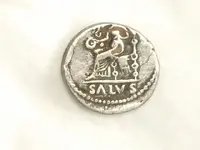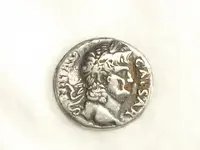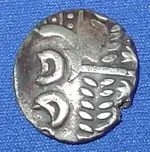jimmy uk said:
just got a Email back from a roman coin expert from the British musum about my coin and there said.....
Thanks for sending me this coin – could we record it on the PAS database?
It’s a plated copy of a Denarius of Nero, imitating issues dating to the period AD 65-68. It’s not a precise copy – the legend NERO CAESAR does not appear for the SALVS type. I don’t see any problem with it being an ancient forgery as it’s
unlikely that any modern forger would go to the trouble of making plated copies!
sounds like good news to me do you think

It 'sounds' good News but I'm still hunting down a good 'expert' on Roman Coins, as they are largely ignored in the UK.
As there is no seams on the edge, I'm much happier its Ancient.

But Ancient what

You would get a much better response from a collector [if your reading this join Tnet

] of these, as they would have access to much larger numbers of this material. I've yet to find one, somewhat proves that although rare, still not that valuable, maybe a little more than the official.
I already tried to illustrate with my picture why someone might have made this coin recently - its just because they can. (not to profit just to play with there skills). So when they
say unlikely, that's what they mean.
I personally go to the British Museum last, they may have masses of material but relatively common stuff like Roman Coins & even 17th C tokens are not getting the attention they deserve. The BM does not actively seek our social history which are present on our 17th C Tokens, & are far from getting 1 of each type. Collections are often built around Greece or other classically trained themes.
I have had a Treasure Report which I proved was incorrect, & I recently was told when researching the source of there information on the maker of a button, that it was basically a guess (& a wrong one in my opinion, plus a couple of other book writers), there was no source & if I find the correct information that they would credit me with the amendments to there records. This was only 18-19th C, this is an area the US put us to shame, there records of this period are much better. Its only as good as the person who logged it, & time is their major issue, shortcuts are made when you have tons of material to get through.
So basically never assume that because it is the British Museum that they 'WILL' be correct.
However, I'm just placing all the arguments out there & my opinion is now 'inline' with the UKDFD & the BM. But personally
I think the story is still only half told, as its all mostly assumptions (like I make sometimes as well) based on best probabilities &
no depth of research in that specific area. You need many more opinions yet or at least the 1 or 2 specialist that might be out there & let me know if you ever find that contact! (I will be interested)
 its been ID as a Nero Fourrée Denarius DATED AD66!
its been ID as a Nero Fourrée Denarius DATED AD66!
 its been ID as a Nero Fourrée Denarius DATED AD66!
its been ID as a Nero Fourrée Denarius DATED AD66!














 it hasnt got a seam around the coin but as you can see on the coin its got 2 seams that it looks like some one has folded the silver over the copper alloy and then hammered it, which makes me thing if some one was gonna fake it in 20th century there would of made a better job
it hasnt got a seam around the coin but as you can see on the coin its got 2 seams that it looks like some one has folded the silver over the copper alloy and then hammered it, which makes me thing if some one was gonna fake it in 20th century there would of made a better job  ] of these, as they would have access to much larger numbers of this material. I've yet to find one, somewhat proves that although rare, still not that valuable, maybe a little more than the official.
] of these, as they would have access to much larger numbers of this material. I've yet to find one, somewhat proves that although rare, still not that valuable, maybe a little more than the official.